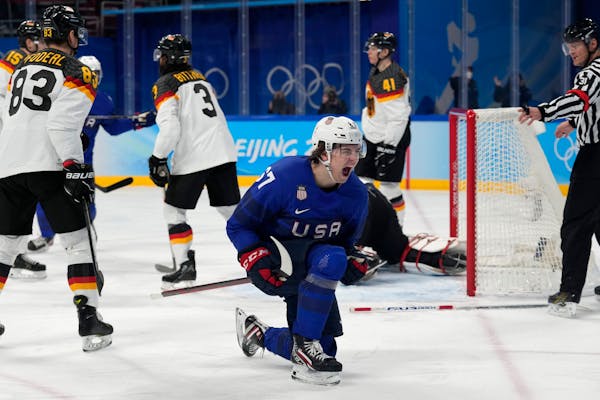BEIJING — It sure looked like the U.S. women's hockey team went to that coveted next level against the Czech Republic on Friday in the quarterfinals of the Olympic hockey tournament.
Stuck in a 1-1 tie through two periods, Team USA turned it on in the third with eight shots on net in the first three minutes. The breakthrough came nearly seven minutes into the third with a tiebreaking goal, then the Americans added two more for a 4-1 win.
There was a determined effort to crash the net looking for rebounds. Defensemen took shots at goal when there were bodies in front of the goaltender. They changed the point of attack at times, trying to generate higher quality scoring chances.
Team USA refused to bow out before the medal round, which would have been a first. There's a trap in thinking that games are like movies and, at some point, there will be a big speech or a secret potion passed around to turn a team into an unstoppable force so it can win in the final period. Or last quarter. Or last inning. Or in extra time. Or on the last lap.
The response against the Czech Republic appears to fall in that bucket. Gigi Marvin, however, said that's not what this particular team is all about.
"Usually the pressure rises because you know it is do or die at this point," said Marvin, a former national team player who currently is an analyst for Bally Sports North. "I know this team so well and the players. They compete just as hard for a preliminary game as they do for a training camp in July that was two years ago."
It's not about raising their game. Team USA keeps the pressure on until the opponent, in most cases, gives way. Even in its loss to Canada to complete group play, Team USA kept firing away at the Canadians until they amassed 53 shots in a game it dropped 4-2.
It would help the cause to turn more shots into goals. Team USA has had more than 50 shots on net in each game of the tournament but has had trouble lighting the lamp at times. Through five games, Team USA leads the tournament with 292 shots on goal, but its percentage of goals from total shots is just 8.22%, which trails Canada, Finland, Switzerland and Japan.
The Americans have run into teams sitting back, blocking shots and clogging things up against them. And a couple of goaltenders have played out of their minds. Team USA coach Joel Johnson continues to tinker with ways to make the offense more robust, and he's encouraged his team to stick with the process of finding solutions.
But there is too much firepower on this team — with Hilary Knight, Alex Carpenter and a line of Kelly Pannek, Grace Zumwinkle and Dani Cameranesi that has taken over games — to not be more productive as it heads into a semifinal against Finland on Monday (7:10 a.m., USA Network), Minnesota time.
Marvin has a feel for the pulse of the team more than most, having played in the three previous Olympics before retiring from the program in December. She knows who the alpha dogs are in the locker room. She knows the standards.
"They have such a good consistent effort and mentality and work ethic," Marvin said, "that I would expect the same or them to be even slightly more dialed in."
Maybe that's what we saw against the Czech Republic. That should help them in the rematch with Finland, who Team USA beat 5-2 in its first game of the tournament. That game will be remembered for the borderline dirty play by the Finns that led to a broken leg and torn ankle ligaments for key forward Brianna Decker. That likely hasn't been forgotten.
Finland won just once during group play, 5-0 over the Russian Olympic Committee, but was able to move on because everyone in Group A was guaranteed a spot in the quarterfinals. A 7-1 win over Japan got the Finns into the semifinals.
It's a team that the USA should, once again, put into its vise and squeeze until it gives way. Then the Americans will be back in the final, looking for consecutive gold medals.

Fleury gets hometown hero treatment — and a shutout — in Montreal

The Vikings were the NFL's oldest team in 2024. A youth movement won't be easy.

Gophers women's basketball team sinks against No. 4 USC

